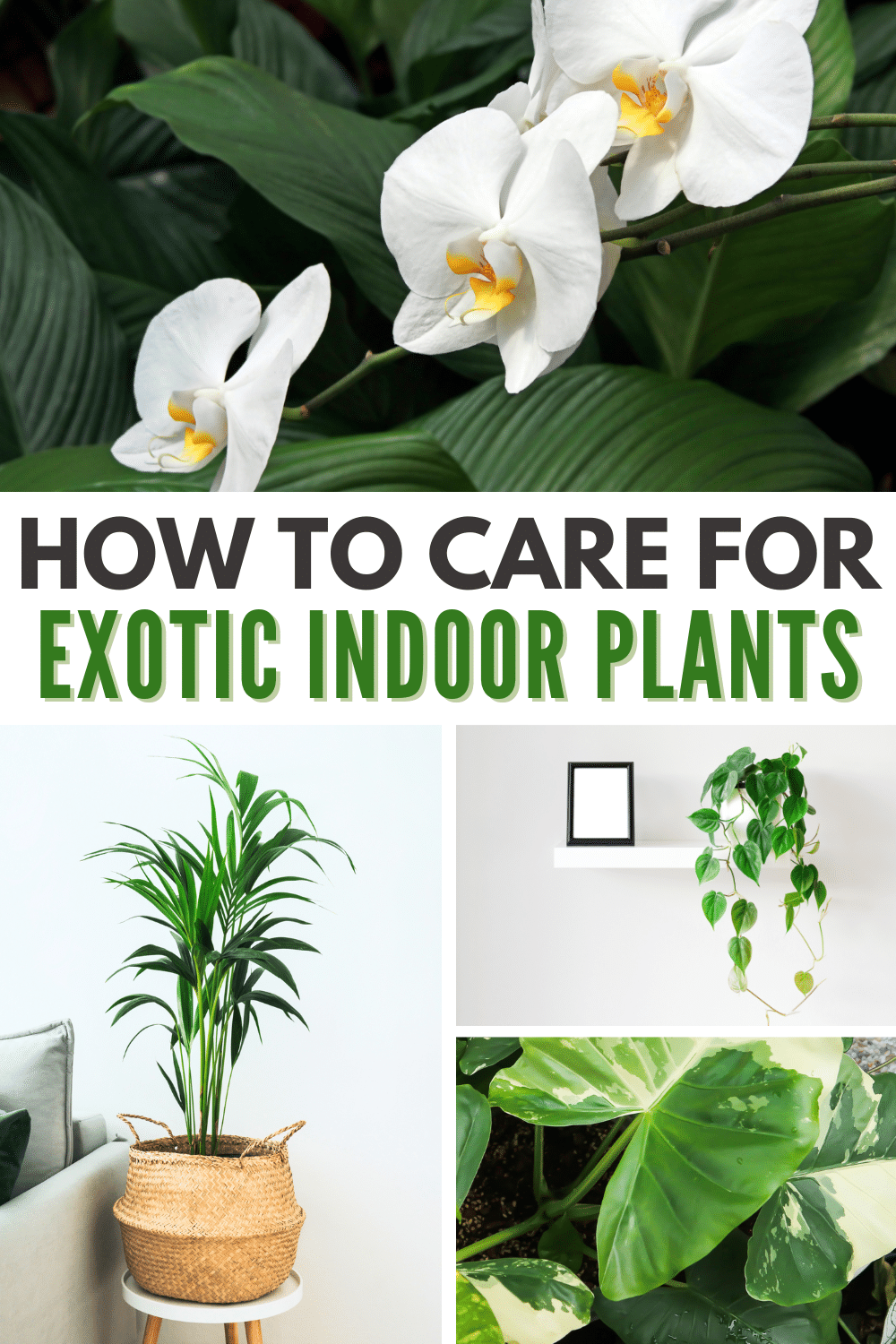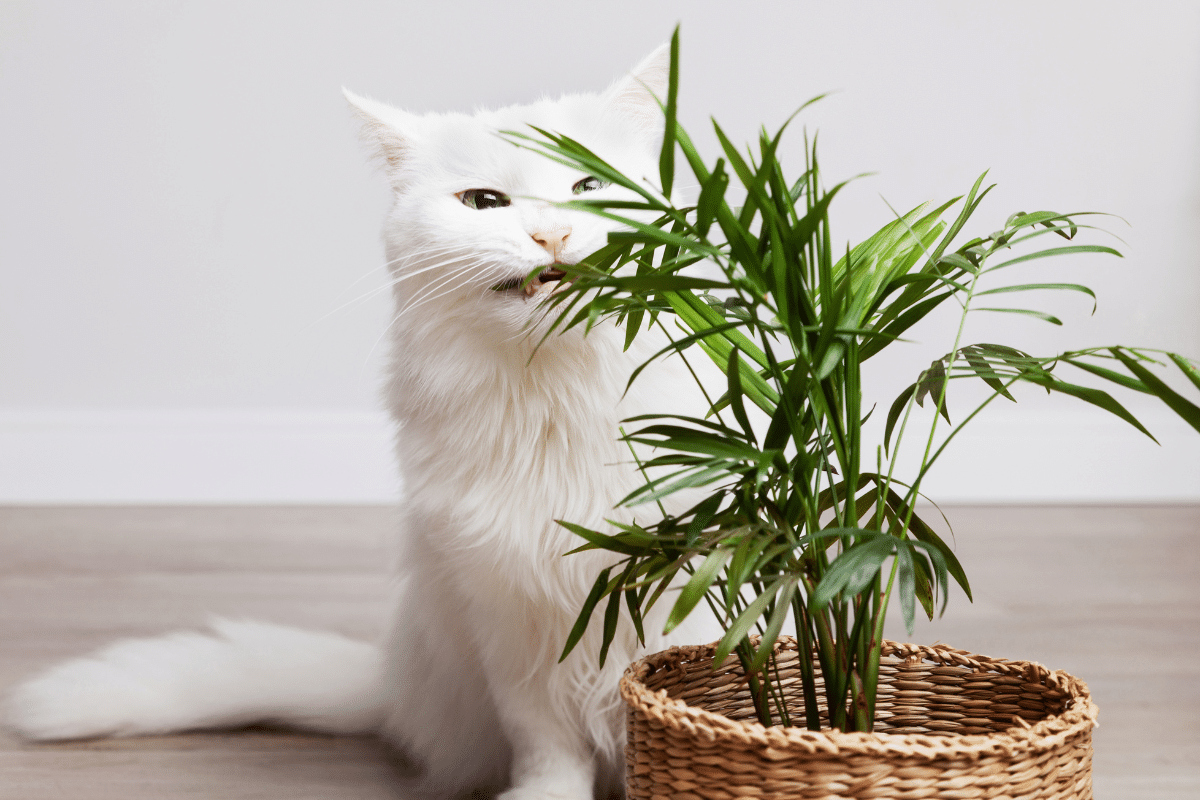One of my favorite home trends has been growing exotic indoor plants. It gave me a new worthwhile hobby that other busy moms will enjoy.

Believe it or not, one of the problems I faced as a beginner indoor gardener was choosing my first tropical houseplant. I wouldn’t be surprised if you’re in the same situation, which likely led you here.
Keep reading to discover some tropical indoor plants that are low-maintenance and easy to grow indoors, even for beginners.
Jump to:
Benefits of Having Tropical Indoor Plants
Beautiful Indoor Environment
This is undoubtedly one of the top reasons many are getting into the trend of growing exotic indoor plants. Why not? Indoor tropical plants are great home decor pieces that can match any motif.
Indoor plants are a feast for the eyes, but seeing lovely plants goes beyond visual aesthetics. Seeing vibrant foliage and majestic indoor trees can also give a sense of having a piece of nature inside your home.
Enhance Air Indoors
Various experiments conducted decades ago and in recent years showed that some indoor plants may help filter out certain air pollutants.
Early research also suggested indoor plants might help reduce airborne toxins like formaldehyde, benzene, ammonia, and trichloroethylene.
Improve Mood and Stress Level
Have you ever noticed how you somehow feel a bit more relaxed when surrounded by plants? Well, it turns out that it’s not just your imagination.
Tons of studies have found that having houseplants do have positive effects on your mood, and they may help reduce stress level. Even the mere hobby of caring for plants might also provide physical and mental health benefits.
How to Choose an Exotic Houseplant for Your Space
Work With the Space You Have
Take a quick tour around your house before getting your first exotic indoor plant.

See what areas need to be spruced up. Then ask yourself a few things. How big is the space? How much light does it get in the morning or the afternoon? Does it get cold drafts?
Consider these things to ensure that the indoor plant can thrive in your space.
Toxic or Non-Toxic?
This is so important, especially if you have kids or pets in the house. There are quite a lot of plants that can be toxic when ingested by humans and animals.

Don’t worry, there are also plenty of non-toxic houseplants you can find. And they will look just as amazing in your home.
Read Up Online and Visit a Local Nursery
It wouldn’t hurt to do some advanced reading on what plants suit you. This should narrow down your list, so choosing a houseplant will be easier.
Make a quick trip to a nearby nursery or greenhouse. Nothing beats seeing these exotic indoor plants in real life. It may even help you visualize better how these plants will fit in your lovely home.
5 Best Exotic Indoor Plants for Beginners
Variegated Alocasia (Macrorrhiza Variegata)
This type of alocasia plant has the familiar glossy Elephant Ear leaves. But unlike other alocasia plants, the leaves have a mixture of green and white colors.

The variegation pattern is so random. There’s often an abstract distribution of these colors, making the Variegated Alocasia leaves look like living art.
A variegated alocasia grows relatively slowly. It could take up to 10 years to reach its full height of 12 to 15 feet.
This type of alocasia plant will thrive with bright, indirect sunlight and in a rich, well-draining, loamy soil. Do note that it’s toxic to humans and animals, so we keep it out of reach from our furry pals at home.
Philodendron
There are two types of philodendron plants:
- Vining philodendron plants look good in hanging baskets, just like the Swedish ivy, or in a pot with a cane where its foliage can climb.
- Non-climbing philodendrons grow upright and can be planted in pots to decorate your home.
The Philodendron hederaceum is one of the most popular climbing varieties, and it’s commonly known as the heartleaf philodendron. It features dark green foliage attached to vining stems stretching up to 13 feet.

Philodendrons generally love bright, indirect light. They can tolerate lower light conditions, which could slow their growth. They’re also toxic to humans and house pets.
Peace Lily (Spathiphyllum)
The peace lily is a great option if you’re looking for exotic house plants. Its main features are the oval-shaped leaves with a glossy green hue.

You may want to keep it in an area with bright, indirect sunlight for a few hours daily. This should allow the peace lily to produce gorgeous white flowers. However, it’s also a toxic plant.
To encourage peace lilies to bloom, you can feed them with a balanced 10-10-10 fertilizer for houseplants every 6 weeks during spring and summer. But use just a quarter of the recommended strength every feeding.
Kentia Palm (Howea Forsteriana)
This is one of the most beautiful palm trees that you can grow indoors. With its splendid palm fronds, it will certainly give your home an exotic, tropical feel. Best of all, it’s a non-toxic indoor tree.

The dark green leaves are pinnate that spread like feathers. Each leaf grows directly from the stem, so they don’t have petioles. When kept indoors, kentia palm can grow as tall as 10 feet.
Kentia palm will produce large fronds when it gets a few hours of bright, indirect light every day. They can survive even in low-light areas but might grow smaller fronds.
Orchids
There is a very long list of species under the Orchidaceae family, but moth orchids (Phalaenopsis) are arguably the most widely available kind.

You’ll often see moth orchids with a lone flower spike. However, it typically has multiple branches that each produce a colorful flower.
Orchids are actually better grown indoors and are widely known as air plants. They’re an epiphyte that need to grow on another plant or tree. To imitate this growing condition, a potting mix for this orchid consists of a mixture of tree bark with peat moss and perlite.
They need water regularly, but check first if the growing medium is already dry. You can also tell by the color of the roots. If they’re still green, that means they’re not thirsty yet. When you see that the roots turn silvery, that’s a sign for you to water them.
Remember to water the roots and never directly on the leaves or flowers.
Exotic Indoor Plants Care Guide
Sunlight
Exotic house plants originally lived under the canopy of huge trees in the forest. So, most of them only need bright indirect sunlight. Don’t let them get scorched by direct sunlight, especially in the hottest hours of the day.
The usual areas in the house that get bright indirect sunlight are spaces near east-facing and south-facing windows.
Water
Most indoor plants, including the exotic houseplants on this list, only need watering once every 1-2 weeks. It helps to water them regularly during the growing seasons in spring and summer.
The best way to tell is by touching the top few inches of the soil. If it already feels dry, that’s a more accurate indication it needs to be watered.
Soil
Aside from orchids, these exotic plants can thrive indoors if they grow in loamy, rich soil. An all-purpose potting mix will work if you ensure it has good drainage.
You can have well-draining soil by adding compost which improves moisture retention.
Humidity
Most exotic indoor plants are native to tropical regions and grow in humid rainforests, so they love some humidity. You can place a humidifier near the plants or put the pot on top of a pebble tray.
Common Problems of Exotic Indoor Plants + How to Solve Them
Tropical houseplants may develop browning, yellowing, and dropping leaves. Their foliage may also wilt or have burnt edges. There are worse problems, too, like root rot.

These problems are often caused by two common errors: overwatering and excessive sunlight.
So make sure that the top inches of the soil feel dry before watering. Houseplants need well-drained soil that retains moisture to avoid getting thirsty for extended periods.
Observe how much sunlight your plants get throughout the day. Most of them only need indirect light or partial shade, if they get this level of sunshine for 4-6 hours a day.
FAQs
A quick online search will lead you to several websites that sell exotic plants. You can also visit local greenhouses and nurseries. You can also find them in farmers markets.
There are a few factors that affect the relatively pricier cost of alocasia plants, including their slow growth rate and the mere high demand for these houseplants.
You can find some Alocasia variants for under $100, though. However, the rare and variegated alocasia plants can easily cost around $200 to over $500.
Most exotic indoor plants don’t need direct sunlight. Too much exposure to direct sunshine could be detrimental to their growth. This could also lead to burned leaves and stems.
Get Exotic Indoor Plants and Have Your Own Tropical Paradise
Having a few exotic plants for your indoor plant collection is a rewarding hobby with relatively minimal effort. That’s because many of them are easy to care for and some are even tolerant of varying light conditions.

So, choose plants that match your gardening skills, and as long as they’re properly cared for, you’ll have a piece of relaxing nature inside your home.


